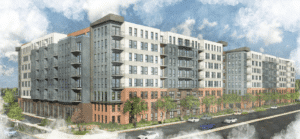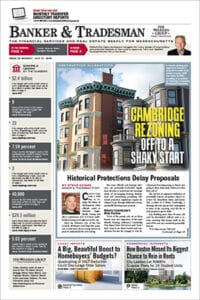
Developer Mill Creek Residential refiled plans in January for a 350-unit complex on Mystic Valley Parkway in Medford under the state’s Chapter 40B housing law after the city lost a lengthy legal battle over whether it was exempt from the law. Image courtesy of The Architectural Team
Last month, Gov. Maura Healey’s Unlocking Housing Production Commission released a report with more than 50 recommendations intended to accelerate housing production in Massachusetts. Some of the most controversial and preemptive recommendations have garnered significant media attention, such as the suggestions to allow multiple units on every residential lot and end minimum parking requirements for residential developments.
In addition, it’s worth paying more attention to the report’s many recommendations that build on existing policies, are much more easily implemented, and would also be incredibly impactful.
Specifically, the report offers numerous ways to strengthen Chapter 40B, the 1969 law that gives developers more leverage to build deed-restricted affordable housing in municipalities that don’t have a lot of it already.
Simply put, Chapter 40B is the state’s most effective private housing production effort to date. Since the early 1970s, it’s produced an estimated 84,000 housing units, more than 35,000 of which are affordable at or below 80 percent of the area median income. For comparison, that’s more than four times the annual production rate of Chapter 40R and more than six times the annual production rate of the Housing Development Incentive Program.
The commission’s report focuses on two crucial areas for reforming 40B: expediting the appeals process and prohibiting communities from using market-rate units to count towards the Subsidized Housing Inventory (SHI).
Make Appeals Faster
Even though municipalities have limited ability to stop 40B projects in communities that do not meet the law’s affordable housing stipulations, local actions and lawsuits can delay the approval of these projects for years and potentially render them financially unviable.
For example, it took 2.5 years for the state Housing Appeals Committee to approve a comprehensive permit for a 180-unit apartment complex in Weston, locally known as the “Weston Whopper,” after the developer initially appealed a local board’s denial of the permit in August 2022.
There are also lengthy cases where abutters appeal the local approval of a 40B project, and still other cases where a locality asserts that they have met one of Chapter 40B’s “safe harbor” provisions, which earns them ultimate discretion to deny 40B projects outright.
An example of the latter is the city of Medford’s unsuccessful 3.5-year effort to appeal a state agency’s September 2020 finding that they had not achieved safe harbor, all while three 40B projects were in the pipeline.
To begin to remedy the situation, the governor’s commission has recommended creating separate pathways for certain types of appeals, increasing Housing Appeals Committee staff and requiring litigants appealing an approved comprehensive permit to post a mandatory bond.
Taken together, these actions would not only streamline the appeals process but also discourage frivolous appeals from the get-go.
Change What Counts for ‘Safe Harbor’
In a separate section of the report entitled “Potential Future Strategies,” perhaps an indicator of policies not yet politically viable, the Unlocking Housing Production Commission also proposed a powerful option for expanding the capacity for 40B projects in dozens of municipalities.
For context, cities and towns typically achieve safe harbor under Chapter 40B when at least 10 percent of their housing stock is included in the state’s Subsidized Housing Inventory. However, the state allows the SHI to include market-rate units built as part of mixed-income rental developments, providing a misleading picture of how much of a community’s housing is reserved for low-income households.

Andrew Mikula
The governor’s commission has suggested phasing out the inclusion of market-rate units in the SHI over 10 years. While the commission doesn’t specify exactly how this would work, one possibility is that the state would allow progressively lower shares of a municipality’s market-rate housing stock to count towards the SHI (9 percent in 2026, 8 percent in 2027, etc.).
The benefit of this gradual approach is that it would give municipalities time to plan for new development or pursue other safe harbor methods while still ultimately requiring them to build affordable housing. The commission found that curbing market-rate units from the SHI “is projected to create capacity for upwards of 100,000 additional units over the next decade.”
The Unlocking Housing Production Commission also recommended that the state update the SHI more frequently, create special grants for communities that exceed the 10 percent safe harbor threshold and remove requirements that projects included in the SHI receive public financing.
This latter reform is a particularly good idea that would reduce administrative costs and lender-imposed requirements on housing that would be affordable regardless of subsidy. In recent years, the majority of 40B units have been market rate, and in some communities profits from the market rate units could fully pay for the provision of affordable units.
In the interest of building on the success of a policy that already has a proven track record, the Healey administration should prioritize implementation of the Unlocking Housing Production Commission’s Chapter 40B recommendations. This is especially true of the changes to the SHI criteria and Housing Appeals Committee staffing, which would not require legislative action.
Chapter 40B is 56 years old and in need of updating to facilitate a healthy pace of affordable housing production going forward. Luckily, the governor’s commission has provided a well-informed blueprint for these updates.
Andrew Mikula is a senior housing fellow at The Pioneer Institute in Boston.






